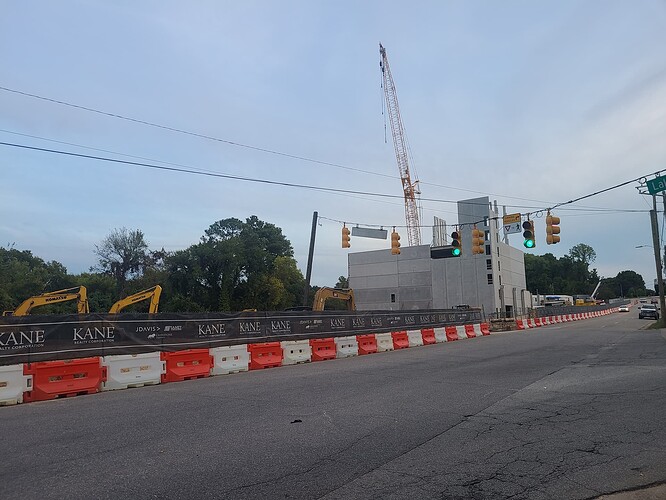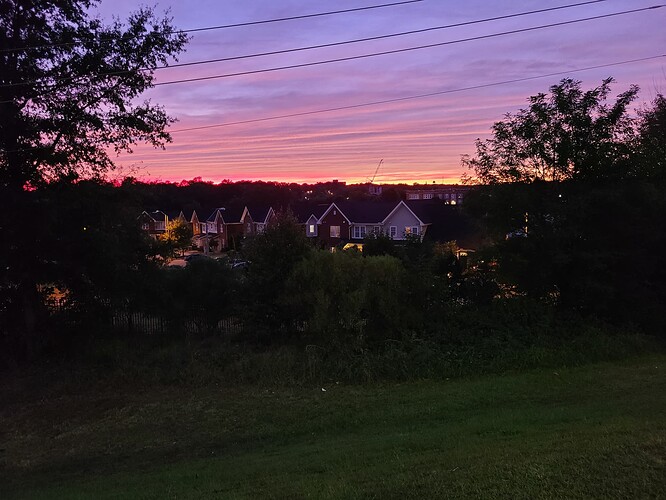I think it is a placeholder “we don’t know what this will be yet” but likely leasable space. Could be small office/co-working or “maker space” or retail or near term storage, long term leasable. It’s certainly set up to be “public” in future
Does the stuff on the west side of Saunders have a name? I thought the buildings on the east side was Park City South ONLY but the rest were just buildings. Let’s clarify this out.
Oh okay I get it now
Not much of an update but this ones for our homie Pedro.
These are from S Wilmington St bridge. Camera phone isnt the best but you can make out the crane.
Parking deck starting to peek out over the trees. Also bonus shot of the Platform development crane.
Even this shorter building is going to have incredible views from its north side.
Maybe we should put Kane in charge of transit…they get ish done!
Pretty sure he’d just drop giant parking garages at every major stop on the line. I love Kane’s work, and he probably does a better job than just about every other developer in the Triangle, but we need to keep in mind that most of his projects are still encouraging car-dependency despite the focus on density. I think most of us (myself included) default to looking at Kane projects through rose-colored glasses because, frankly, they’re good projects. That shouldn’t make him immune to criticism.
Edit: I also highly doubt that dude takes transit anywhere ever (please prove me wrong, though), and I don’t want someone who doesn’t ride transit at least semi-regularly planning transit.
I’m all for increased density, but like it or not, Raleigh is currently an overwhelmingly auto dependent city. Without the critical density, transit isn’t supported, so until we arrive at that tipping point, we (developers/society) still have to find a place to put the damn cars.
In the grand scheme of things, Raleigh is still an infant city (even by American standards). Buildings only have XX number of years of a lifespan before they are torn down and replaced with something bigger (or in the Highwoods case, a gravel parking lot…). It is the evolution of cities around the globe. We just happen to be living an a very young city that is hitting a growth spurt. To have all the density/transit/critical mass we all think we need/want/should build, I just don’t see it in the cards for Raleigh during my lifetime. Sure my kids/grandkids may see that happen in the future. #RealityCheck
I chose to live in a semi-walkable suburban North Raleigh neighborhood and I appreciate that choice everyday. However, I realize that I am but one citizen with a preference to walk rather than to drive for mundane tasks/errands. There will have to be a serious cultural shift in mindset before walking becomes the norm over hopping in the car to drive the 1/4 mile to the grocery store up the street. Ironically, look at all the money spent to go (drive) to a gym just to walk on a tread mill or ride a stationary bike, when if incorporated into daily habits, you would get the same benefits without the waste of money. End of rant, here’s my soapbox.
To me, this is what is so frustrating about the decades long battle over transit.
I think its clear that we are going to have many clusters and nods of density over the city and county. If we had rail in place, that would drive some of the clusters. Instead, we will be trying to connect the clusters.
40s years of talking and planning and we are getting a BRT - better than nothing for sure, and practical and politically acceptable choice, but still disappointing. Like hoping you’d get a toy train for Christmas and instead get underwear.
Putting together a precast parking deck isn’t exactly the most labor intensive thing in the world. They go up pretty quick. It’s basically Legos.
True. I was focused on the ‘getting done’ part, not the rolling with capitalism and its cars part in my comment above. Dang y’all, it was tongue in cheek… 
One random thought from last night, after driving 3 miles from my neighborhood to Glenwood to eat at La Santa. I think a lot of people have fear that if we take space away from cars (lanes, parking) they won’t be able to access the places they love. It’s coming from a misunderstanding of what dynamic, growing neighborhoods would mean for their lives. Reducing car dependency and car infrastructure, coupled with gentle densification and neighborhood thickening could mean better access to amenities. True, it may take 10 minutes longer for one to go to that restaurant or those shops, but in the long run it means one can safely walk to a similar quality place within one’s own neighborhood.
People don’t recognize the full picture, of bringing the places they love closer and therefore not needing those extra turn lanes and parking decks.
I’ve tried to make a related point at community meetings/rezoning meetings, etc., which is: how I get to your business (restaurant, bar, coffee shop) plays a huge role in how I experience your business, whether or not I form positive opinions of it, and whether or not I’m going to be a regular customer. There are already so many businesses that require me to drive to them (despite living two miles from downtown) that I’m not very interested in exploring new ones that require driving. Now, open a restaurant, bar, coffee shop, brewery, fill in the blank that I can walk or bike to and I will make every effort to patronize your business and keep it going.
Ultimately, I feel like we are of the same mindset. As are most of us on this forum.
I completely understand the want and desire to support local/neighborhood businesses. However, businesses require $$ to stay open. The more people a business serves, the more healthy they are as a business. Factor in the sky high rental rates they are paying for their (newly built) tenant space, and they HAVE to make XX dollars per month just to stay open. The neighborhood may love said shop/cafe/etc, but that may not be enough to keep their doors open.
We have a cultural mindset to drive, drive, drive, drive, even if the actual distance is pretty short. (Hell, I’m married to someone who thinks like that  ) I just have to have faith that the overall mindset will shift and we’ll go back to the pedestrian first, car secondary mentality.
) I just have to have faith that the overall mindset will shift and we’ll go back to the pedestrian first, car secondary mentality.







